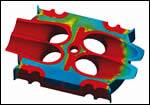Choosing and Using the Right Mold Cleaners
Knowing the requirements of offline and online cleaners yields cleaner molds.
Cleaning molds is a key part of running a successful injection molding operation. There are two situations when mold cleaning is required: (1) offline when the mold is on the bench and is cold [room temperature] and (2) online when the mold is warm and still in the press.
Because of temperature differences, the cleaning solvents may have different degrees of effectiveness. Solvents that work well on the bench and evaporate at a convenient rate are usually flashed off very rapidly on a hot mold and aren’t in contact long enough to do much cleaning.
Solvents that work well at higher temperatures are much less aggressive and effective at room temperature. They take longer to evaporate or may even have to be wiped off. Using the wrong cleaner may result in poor cleaning or excessive time to accomplish the job.
The requirements of offline cleaners are primarily to dissolve resins, grease, oil, mold release and sometimes rust. These cleaners generally are required to have a very fast evaporation rate. The best cleaners for this are chlorinated hydrocarbons, but some non-chlorinated hydrocarbons and naphthas also are good. They can readily dissolve greases and oils by merely flushing the mold with a heavy spray from top to bottom.
Mold releases and resin build-up may require scrubbing the mold with a cloth saturated with the cleaner. A new technology that has recently been introduced into the marketplace is the pre-saturated mold cleaning wipe. These wipes are generally packaged in a canister similar to what would be found with baby wipes. The advantages of using such a cleaning wipe include the following:
- Guaranteed sterile, lint-free and clean cloth
- Ideal for precision cleaning
- Pre-saturated with the ideal amount of cleaning solvent included
- Easy-to-use and non-hazardous disposal
A final option for offline cleaning is the use of a mold polish and cleaning compound. These products are typically used in paste form and require manual application as well as removal. The typical mold polishing paste contains a combination of cleaning solvents and mild abrasives that are designed to aid with the removal of all contaminants from the mold or die surface.
An added benefit of using such a polishing paste is the resulting sheen or luster that is generally left on the mold surface. Such a finish serves as a natural lubricant and release, thus minimizing the need for a mold release to be used later once the mold is put back into production.
Online cleaners are generally used to remove mold release build up, plate out of resins and light rusting of the mold. Often molds get plate out, which is due to the adhesion of resins [some acetals such as Delrin or Celcon© have been common offenders in the past] or fire retardant materials. Such build-ups must be chemically removed from the mold surface in order to minimize potential part deformation. A resin-removing product can chemically work to break down the material and to aid with the removal of the unwanted resin from the mold surface.
As a general rule, cleaning solvents used on a warm or hot mold should be much slower evaporating. This allows for the chemicals to remain on the mold surface for longer periods of time, thus maximizing the cleaning potential.
Related Content
Machine Hammer Peening Automates Mold Polishing
A polishing automation solution eliminates hand work, accelerates milling operations and controls surface geometries.
Read MoreWhat is Scientific Maintenance? Part 2
Part two of this three-part series explains specific data that toolrooms must collect, analyze and use to truly advance to a scientific maintenance culture where you can measure real data and drive decisions.
Read More5 Hot Runner Tips for Moldmakers and Molders
Best practices for initial hot runner tryouts and effective preventive maintenance.
Read MoreBreaking Down 3D Scanning in Moldmaking
Identifying 3D scanning requirements and implementing the appropriate technology.
Read MoreRead Next
Cleaning Molds: Part I
Cleaning a mold is a critical part of the repair process, but many myths must be dispelled.
Read MoreHow to Use Strategic Planning Tools, Data to Manage the Human Side of Business
Q&A with Marion Wells, MMT EAB member and founder of Human Asset Management.
Read More


















